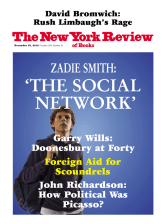In response to:
The Slump Goes On: Why? from the September 30, 2010 issue
To the Editors:
I am a great admirer of Paul Krugman, especially his timely writing in these pages, in his New York Times column, and on his consistently insightful blog. And I agree with practically all of the recent pieces that he coauthored with Robin Wells, including their dismissal of the commonly held belief that the Federal Reserve should have raised the federal funds rate long before it did so in June 2004 [“The Slump Goes On: Why?,” NYR, September 30, 2010, and “The Way Out of the Slump,” NYR, October 14, 2010]. But that is not to say that Federal Reserve interest rate policy had nothing to do with the crisis.
As I see it, the issue is not so much whether the Fed should have begun raising interest rates earlier—it should not have done so, as Krugman and Wells make clear—but whether the slow and steady pace at which it raised the federal funds rate (the rate banks charge one another for overnight loans) helped to create a false sense of security and stability that enticed financial institutions, investors, and home owners to leverage their investments enormously. The Fed’s policy not only reinforced the complacency in the financial markets that had built up over the previous two decades, the period many economists call the “great moderation.” By removing the possibility of sharp increases in interest rates, it also eliminated one of the major threats to taking on more leverage and heightened some of the most misleading aspects of the risk models used by financial firms and investors.*
The Fed’s failure to act aggressively after June 2004 was especially important in light of the downward pressure exerted by the “global savings glut”—capital flows from developing to developed economies—on longer-term interest rates such as mortgage rates, which matter most for spending. Alan Greenspan, Federal Reserve chairman during most of the period, has claimed—incredibly—that he was unable to raise mortgage rates much, and thus moderate the housing bubble, in the face of these capital flows. But how could he know since he never tried more forceful action!
At the very least, raising the federal funds rate more aggressively, say to 3 percent or so in the six months after June 2004, would have limited the growth of adjustable-rate subprime mortgages (which are based on shorter-term rates) and the derivatives linked to them, markets where some of the most irresponsible lending and trading occurred. And this was the period when the housing bubble inflated most rapidly.
Krugman and Wells write that the housing bubble “got started largely thanks to the global savings glut, but…it developed a momentum of its own—which is what bubbles do.” The great tragedy is that the Fed made no credible attempt to short-circuit the bubble’s momentum, a failure that is even more pronounced since traditional monetary policy rules like those the Fed uses, which don’t even contemplate puncturing bubbles—show that overnight rates should have reached 3 percent by the end of 2004.
Roger Alcaly
New York City
This Issue
November 25, 2010
* See Roger Alcaly, “How They Killed the Economy,” The New York Review, March 25, 2010.



